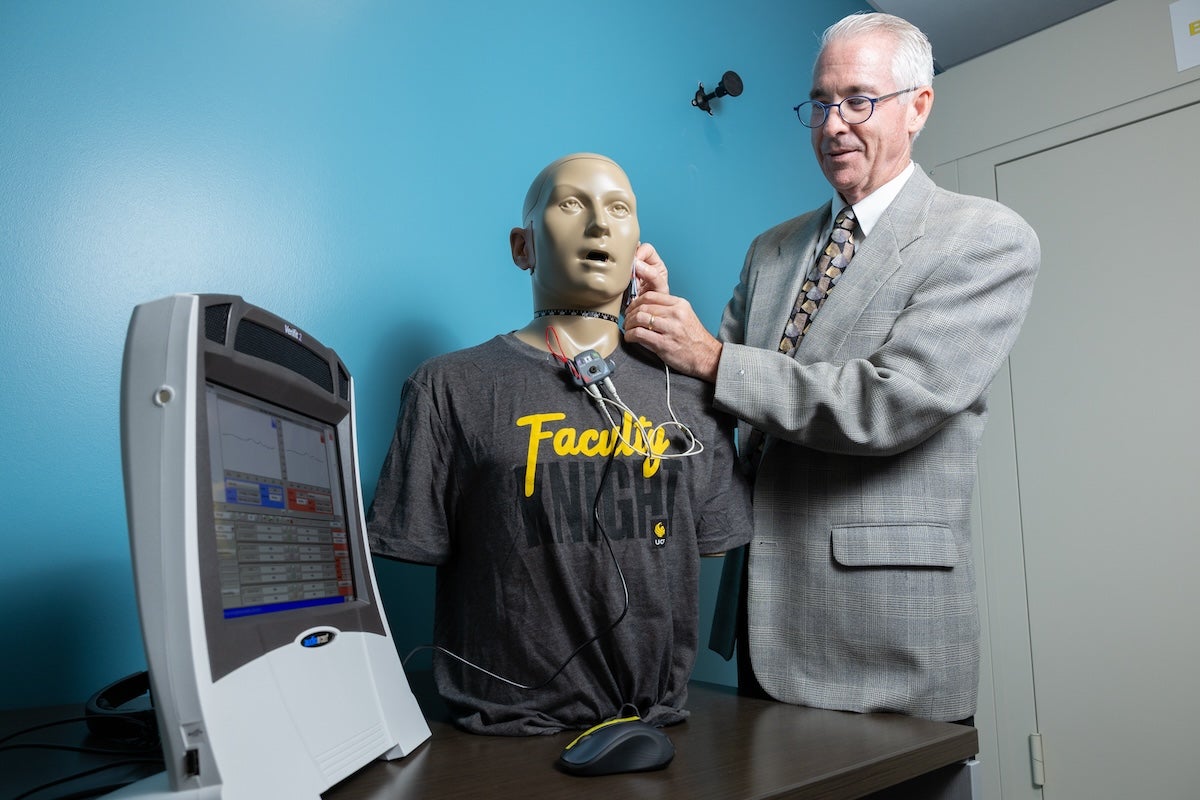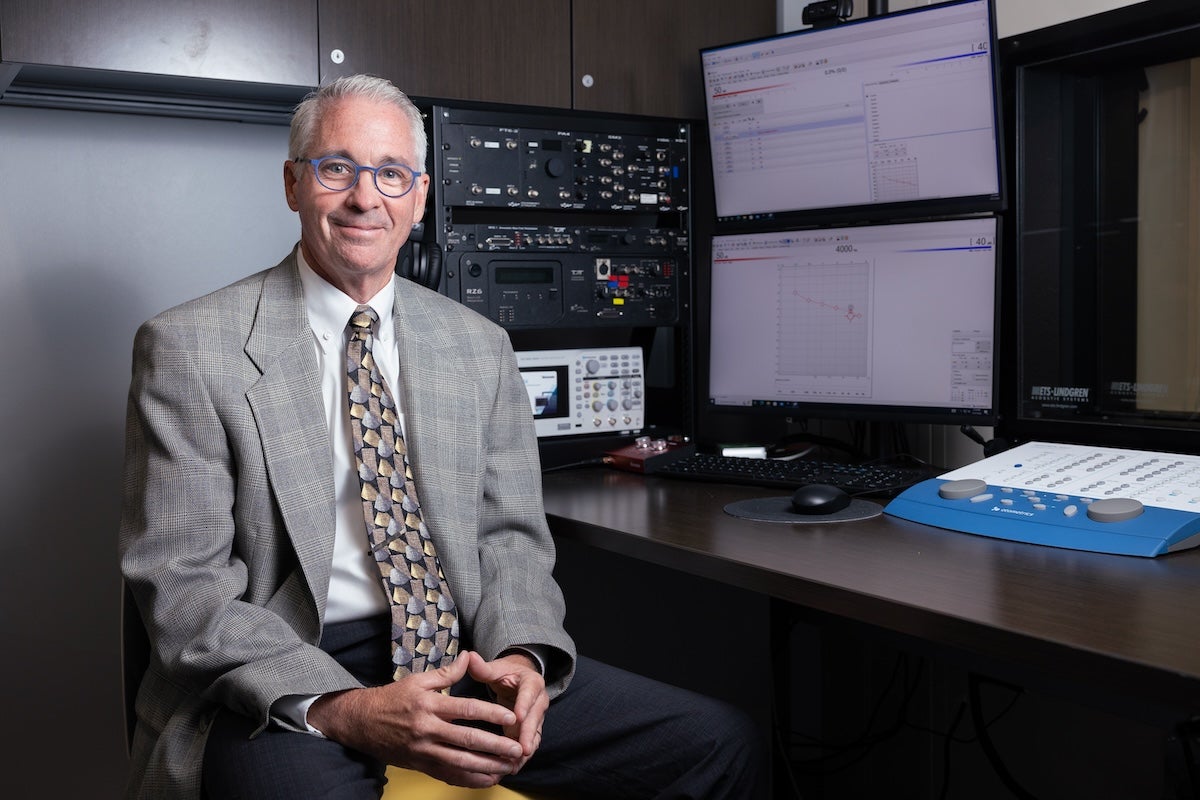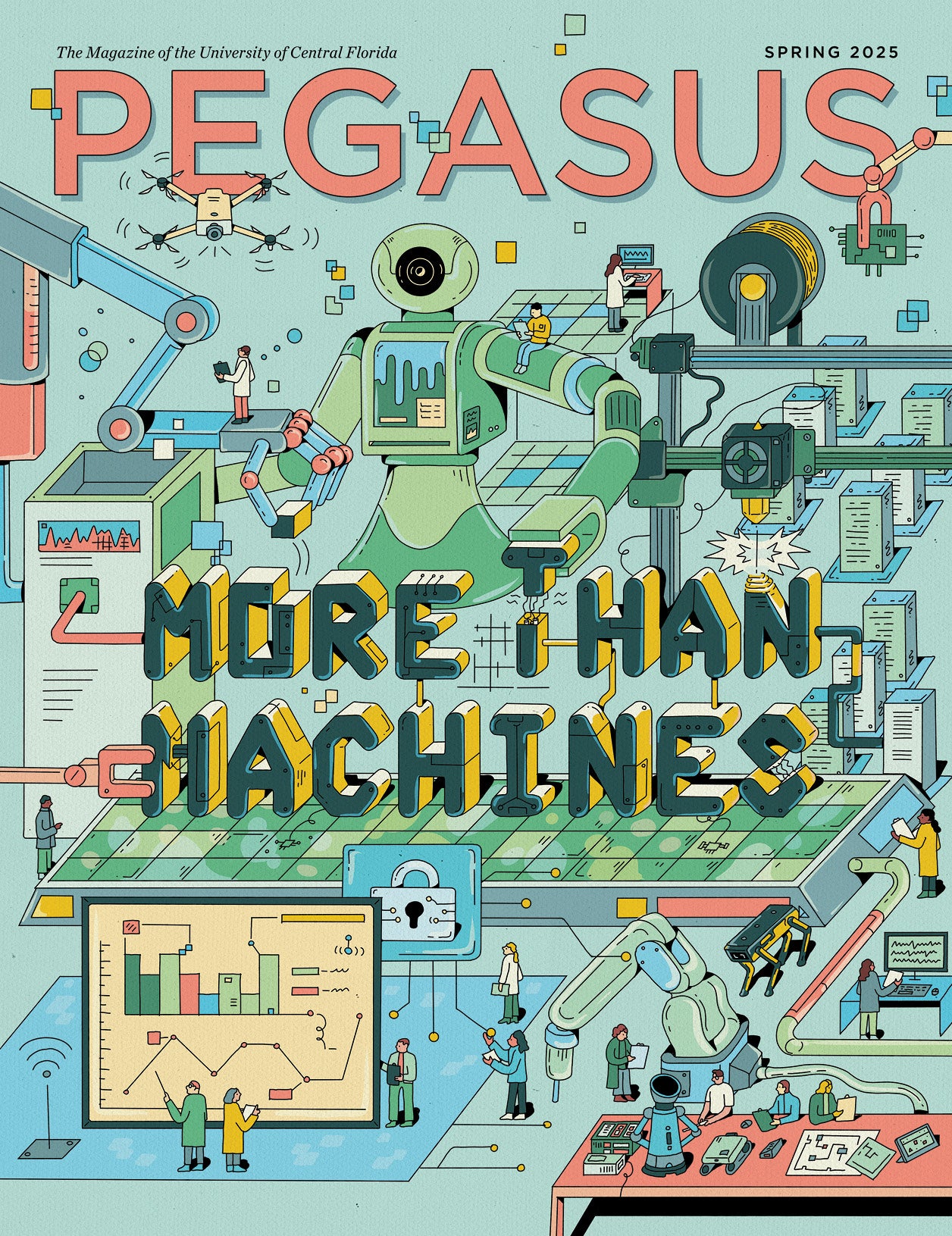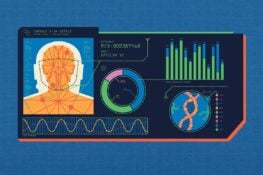A classical psychoacoustician and a clinical audiologist, Professor David Eddins is regarded across the country for his research to address hearing impairments and his discoveries leading to the improvement of diagnostic tools and hearing enhancement devices. He joined the College of Health Professions and Sciences(CHPS) last fall with more than three decades of research in the speech, voice and hearing sciences. At UCF, he’s ramping up his pioneering work to develop assistive technology solutions that improve the quality of life for people with hearing challenges and create more effective tools for the clinicians treating them.
According to the National Institutes of Health (NIH), approximately 15% of American adults, or 37.5 million people, report some trouble hearing. The developments taking place in Eddins’ newly created Communication Technologies Research Center have implications for children and adults facing hearing challenges that stem from trauma, disease and neurodevelopmental disorders, as well as those with age-related conditions and for patients like professional singers or athletes who rely on voice, respiratory and speech health.
The center, based in the CHPS Office of Research, targets four focal areas: voice and upper airway disorders, auditory neuroscience, hearing technologies and simulation technologies. It includes Eddins’ longtime associates, Research Professor Shaheen Awan and Research Assistant Professor Yeonggwang “Paul” Park, both of whom also joined CHPS in Fall 2023, and Ann Clock Eddins, who is a professor and director of the School of Communication Sciences and Disorders and brings research expertise in auditory neuroscience. New to the center this summer are Assistant Professor Andy Dykstra and Research Assistant Professor Monica Folkerts. Plans are in place to hire five additional faculty members in the months ahead.
A More Intelligent Hearing Aid
Eddins comes to UCF after 13 years at the University of South Florida (USF) where he served as the director of the Auditory and Speech Sciences Laboratory, a multidisciplinary research facility dedicated to improving hearing and communication. For the last two years, he and his team have been working to develop a “smart” hearing aid that can predict the intent of a user and intuitively change the way it processes sound to meet the goals of the wearer.
Hearing aids made with today’s technology simply process sound and don’t know anything about the wearer’s intent or how they want to interact (or not) with sounds and the environment. Eddins is creating a device that uses accelerometers to receive data about head movements and provide indicators of what the user is doing and their hearing needs, which in turn enables the device to adjust itself accordingly.
“Imagine you’re really engaged in conversation and you’re nodding up and down, shaking your head left and right, laughing and talking. Those actions and movements may be associated with turn taking and looking at communication partners and can convey that you’re trying to understand what’s going on,” Eddins says. “In that situation, you might want the hearing aid signal processing to be aggressive to maximize clarity of other people’s speech and focus on individual speakers, and for background noise to be minimized.”
In addition to making current hearing aids available more intelligent, the technology could also be extended to cochlear implants and any other head worn systems developed in the future, including the possibility of small, head mounted chips that interface with smartphones.
Grants from the hearing aid manufacturer Sonova support the project, which is in early stages. Eddins and his collaborators are currently examining the accelerometer technology available, establishing benchmarks for accuracy, and studying and coding head movements during natural conversations to better infer patterns. Eventually, they’ll tie the patterns of head movement and measures from other sensor technologies to the associated communication actions.

Simple Yet Highly Sophisticated
Eddins and Awan have been collaborating for several years to find new ways to better diagnose and treat voice disorders. Their current projects include a five-year $3.12 million NIH grant to develop a more accessible and affordable tool for speech-language pathologists (SLP) to conduct more comprehensive patient evaluations.
One of the components of a voice evaluation is a respiratory evaluation, which can assess the air coming through the lungs to the vocal folds.
“The challenge is that most SLPs who do voice evaluations don’t do a respiratory evaluation,” Eddins says. “Part of the problem is that the equipment is expensive and not very accessible or user friendly.”
Awan and his son Jordan Awan, a researcher at Purdue University, developed a 3D-printed handheld whistle that a patient blows into, producing a sound frequency directly proportional to the air flow the patient is generating. An accompanying smartphone app measures the pitch of the sound and provides an accurate measure of the patient’s breathing capacity.
The device can obtain the same information as medical devices on the market that sell for hundreds to thousands of dollars, Eddins says. He envisions the whistle one day being available in individual, disposable packages. The simple yet highly sophisticated solution could potentially be used by SLPs to accurately measure respiratory function in patient evaluations, as well as by clinicians in other disciplines, like sports medicine practitioners, or even a general practitioner who needs to assess breathing capacity to help diagnose a respiratory illness.
The grant is enabling the researchers to evaluate the whistle across the lifespan and, along with research partners across the country, establish its viability for future clinical use. A mechanical engineer at Purdue University has developed a fluid dynamics model and is helping to optimize the whistle’s performance, and scientists at Emory University are evaluating its utility with patients at a voice clinic.
Assessing Voice Disorders
Eddins and Awan are also studying adult and pediatric voice disorders, focusing specifically on developing better tools for clinicians to more effectively evaluate the perception of a patient’s voice thanks to a $3.17 million grant and a second $2.9 million grant, both from NIH. This work began over a decade ago with Eddins’ long-time research colleague Provost Rahul Shrivastav at Indiana University.
Voice disorders can be caused by a wide variety of factors ranging from vocal abuse (which can be anything that strains the vocal cords, like too much talking, laughing or shouting), to exposure to chemicals or smoking, and medical conditions like cancer or certain diseases that affect the nerves that control the vocal cords. Factors like these can cause vocal cords to vibrate abnormally, causing patients to experience problems with pitch, volume or voice quality.
Pediatric voice disorders are rarely researched despite being very common. The intubation of infants can damage their vocal folds, sometimes rendering them non-functioning, and when this occurs, a child may vibrate their mouth to create speech and sounds, instead of using vocal folds.
Eddins and colleagues want to examine the validity of tools currently being used by SLPs to assess voice perception. Today, that typically involves a SLP rating what they hear when a patient speaks on a Likert or a visual analog scale, for example, by assigning a number between one and 100. These methods don’t always provide reliable data.
“No one has systematically compared the effectiveness of current clinical tools to those we have developed in the laboratory,” Eddins says. The long-term goal is to translate robust measurement methods used in laboratory investigations into more reliable and valid clinical tools that are accessible, affordable and easy to use.
Stopping Sound Sensitivities
Eddins’ past work includes the development of a patented hearing device and treatment method to help people with severe hyperacusis, a condition that produces an abnormal sensitivity to sound. Patients with this condition are unable to even tolerate common everyday noises like dishes clanging or doors slamming, and the condition can have an adverse impact on quality of life. There are no medical treatments currently available.
“The idea is that you need to somehow make these louder sounds that are offensive and uncomfortably loud, more comfortable for these individuals,” says Eddins, who developed a device that produces sound therapy to enable patients to better manage their condition. The devices protect against exposure to high-level sounds while providing a constant, low level, soft, therapeutic background sound which gradually builds a higher level of tolerance for patients. At the same time, the device automatically adjusts itself to protect against new sounds a patient would find aversive.
“Over time, we basically are altering the way their brains are responding to high level sounds, reducing the excitability of the central nervous system to those high-level sounds,” Eddins says. “If sound levels in the environment get up to be above your tolerance, devices turn down the sound level, so they actually kind of function like ear plugs when you need them by reducing sound level, but when you don’t need them, they’re providing healthy, comfortable sound exposure all the time.”
In a clinical trial, Eddins’ sound therapy was coupled with traditional counseling specific to patients with hyperacusis, a combination that together yielded a significant improvement in their ability to tolerate high level sounds.
He plans to pursue a larger scale field trial, with multiple sites. He also believes the treatment is promising for people with autism spectrum disorder, a population that often experiences abnormal sound sensitivity.
Changing the Brain
Eddins’ work to address hyperacusis is an extension of his interest in neuroplasticity, and his development of sound therapies designed to help the aging population adapt to hearing changes and the associated natural changes that occur in the way the brain processes.
A patent is pending on his second sound therapy device, this one targeting the specific auditory deficits most likely to occur with age-related hearing loss.
“Most people think of hearing problems as a hearing loss, like you don’t hear certain soft sounds,” Eddins says. “But another type of hearing problem is that sounds have some acoustic property that your brain just doesn’t process or interpret very well. And there are lots of different types of acoustic properties that need to be processed.”
His sound therapy device can distinguish between the processing deficits and tailor the therapy provided — whether that’s providing a soft noise or adjusting certain speech sounds commonly misheard.
“Rather than just put a hearing aid on, what we would like to do is change the way the brain reacts and responds and processes,” Eddins says.
In the new Center, Eddins and the team will continue their research, clinical trials, and the development, design and validation of diagnostic instruments. They’ll coordinate product field trials; conduct product testing, evaluation and comparisons of hearing enhancement and hearing protection devices; and provide behavioral and electrophysiological assessments of hearing and auditory functions.
The team was recently funded by Sonova to study the interaction between hearing loss, hearing aids, communication and cognition. The focus of this investigation is to determine how hearing aid sound processing may improve communicative and cognitive function by employing a unique combination of cutting-edge laboratory measurements as well as real-time measurements of communicative and cognitive function during the course of a person’s everyday life.
Additionally, the center will focus on using simulation technology to further their research in developing educational and teaching tools, as well as for translational clinical practice.
Eddins is a fellow of the Acoustical Society of America and the American Institute for Medical and Biological Engineering. He earned a bachelor’s in speech and hearing sciences and a master’s in audiology from the University of North Carolina and a doctorate in experimental psychology from the University of Florida.





